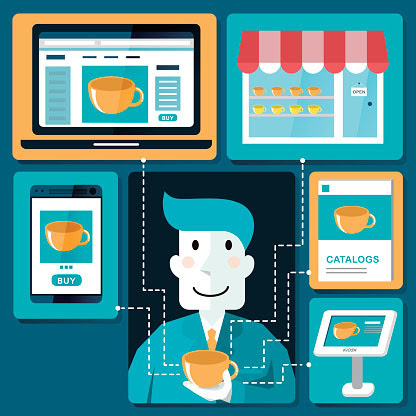Omnichannel is the Key to Optimizing Customer Experiences
What does Omni-channel mean?
Historically, companies were focused on providing customers with the ability to transact in the channel of their choice. Organizations were organized around channels, and each channel’s department had their own reporting structure and goals. The departments often encouraged channel competition, but the end result was confused customers who experienced different offers, pricing and processes in each channel.
Omni-channel is a multi-channel approach that provides the customer with aseamless experience, whether they are transacting online, from a desktop or mobile device.
Today, companies are focusing on creating omni-channel experiences to ensure that no matter where the customer is located, or on what device they are interacting with, the experience is the same.
Online, mobile, and social media platforms have enabled customers to not only switch between channels quickly but to also use them simultaneously. It is a regular occurrence to see people in store aisles looking at product reviews and pricing on their mobile while deciding between products on a physical retail store shelf. They are using mobile, in-store advertising, and in-store sales representatives combined to help with their decision making process.
Why Omni-channel?
Unfortunately, there are way too many examples of companies that fail to deliver good omni-channel customer experiences. A few years ago, I called my bank’s 1-800 number to secure a car loan. Everything (or so I thought) was confirmed over the phone. I faxed in my signed documents, and was told I could go and pick up my cheque at my local branch. I waited in line at the branch only to get to the counter and be told, “Oh no, you cannot just pick up the cheque”. I asked how they could be so disconnected and their response was, “Well, we are not the same as the call centre. We have different rules”.
The result was a very negative experience. I walked away thinking that the bank does not understand me as a customer, and clearly does not realize I have a mortgage, GICs, RRSPs, RESPs, etc… Not only were they at risk of losing my car loan, they now faced the risk of losing my business to one of their competitors.
Having been in digital since the days of Netscape, I am definitely a digital advocate, interacting digitally is my preference. But, there are certainly times when I prefer face-to-face interaction. Human interaction is a vital factor in a positive customer experience even in the digital age.
In fact, a study done by Accenture found that only 36% of customers believe digital channels are better than non-digital forms of interaction. Additionally, 58-73% prefer dealing with humans to get quicker answers, resolution on issues, and to get advice[1].

Many studies have found that customers who engage across multiple channels are more valuable customers. In fact, multi-channel banking customers purchase 1.4 times the products and are 15% more likely than digital-only customers to serve as advocates for their providers.[2]
Digital does not always offer marketers the ability to up-sell or cross-sell based on the customer’s needs. Digital can ‘recommend’ based products you are looking at in real-time. Sometimes, we see up-sells based on our previous buying behavior – but I still get irrelevant Minecraft recommendations because my son and I surf on the same computer. And rarely do I see up-sells and cross-sells based on my ‘stage of life’ or my ‘in the moment’ needs.
The ability to truly understand the customer is lost if their only interaction is online.
Ironically, many companies are also finding that the selling expense associated with digital exceeds the value of their digital investments. The savings from the efficiencies of customers transacting online are often offset by the necessity to offer lower prices through promotions and discounts – to compete in the one click away environment. Rate comparisons or insurance quotes are always 5 seconds away. Digital is further commoditizing financial products; foreign currency exchange, insurance quotes, and loans are available online.

In fact, an Accenture survey found that more than ½ of customers want their bank to proactively recommend products or services that would help them financially. And 55% said it would strongly increase their loyalty to the bank. Many would even pay for budgetary advice.
A simple idea such as the Investment Advisor making notes on a client’s life changes into an omni-channel CRM, could positively impact revenues. The in-branch bank manager would better understand the client and be able to make recommendations and offers of true value to the client.
Barriers to Omni-channel.
Offering proactive digital financial advice and counselling to help clients better manage their financial needs can provide valuable insight and offer huge incremental revenues and increased loyalty.
Barriers to Omni-channel
In order to embrace omni-channel strategies across the organization, companies must first understand the economic benefits of providing customers with the ability to interact seamlessly across channels. The silos need to begin to blend and they must agree that a one-size-fits-all approach to customer experiences will not work.
The story about how my telebanking institution did not communicate with my branch nor have the same rules for picking up my car loan cheque, was probably due to technology and/or the lack of desire to improve their processes. Omni-channel requires a focused customer-first agenda – a strong understanding of customer data and a willingness to change. Barriers include:
- Inability to provide all divisions with a single view of the customer across channels
- Inability to understand the customer beyond their buying history
- Lack of system integration
- Lack of training, education, processes, and inadequate change management
How to get started
The core of an omni-channel strategy is the ability to understand the customer. Omni-channel warrants an outside-in view and a mapping of the customer experience from the customer’s perspective. The omni-channel approach puts the customer, not the business units, at the centre.
For financial institutions, a front-end portal or “window” into the back-office, can help bridge the silos. Starting with a single view of the customer, you can direct the client standing in the branch, help the bank manager understand the value of the client, the call centre to appropriately service the client, and give the Financial Advisor a better indication on which products to recommend. A portal is not as big of an undertaking as re-building the back office and it can create and connect personalized digital experiences across the omni-channels.
Considering the customer journey from an omni-channel experience instead of just one department or a branch’s interactions is a start. Understanding customers beyond the personas is the next step to creating fantastic omni-channel customer experiences.
Valerie Jones will be at the Digital Marketing for Financial Services Summit on the Power Panel: Omni-channel Surmount Barriers to Transform your Omni-Channel into a Customer Centric, High Performance Digital Ecosystem. June 2, 2016 at 9:15 AM.
———————
[1] https://www.accenture.com/us-en/insight-digital-disconnect-customer-engagement.aspx
[2] https://www.accenture.com/us-en/insight-digital-disruption-banking-north-america-consumer-survey



![8 Web Design Trends That Will Take 2016 By Storm [Infographic] 8 Web Design Trends That Will Take 2016 By Storm [Infographic]](https://veriday.com/wp-content/uploads/2015/12/pexels-photo-261706-180x180.jpeg)







